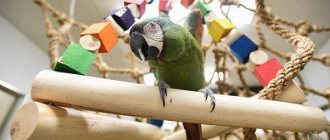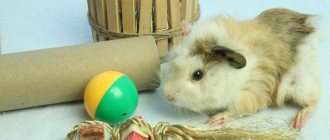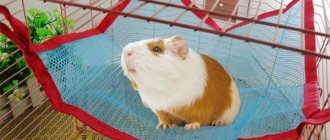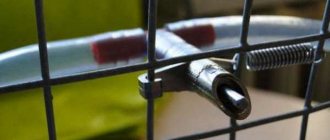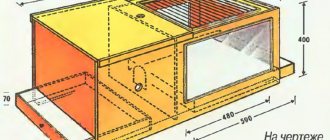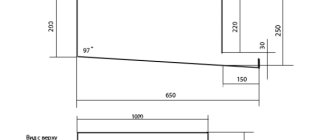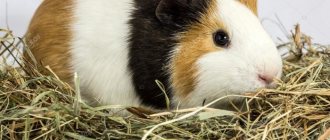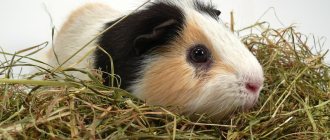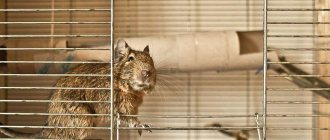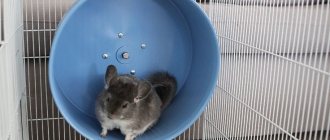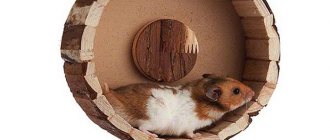A guinea pig rack is a great alternative to a cage. Buying a spacious home for a pet is often problematic. But placing such a large pet, compared to other rodents, in a small house is also not an option. For an animal to be healthy and cheerful, it needs to move a lot, and this requires a sufficient amount of free space. The problem is solved by creating a shelving house for the animal with your own hands. This will provide the pig with space for entertainment and freedom of movement, but will not require large material costs.
The advantages of such housing for guinea pigs
Furry rodent shelving has many different benefits. The structure, like ordinary furniture, is easily matched to the interior. If you focus on the surrounding environment when creating a structure and developing its design, then the pig rack will become a real decoration of the room. Inside such a home there is a place to place everything that a pig needs to be happy:
- privacy shelters;
- feeders and drinkers;
- stairs;
- tunnels, etc.
There is no need to make playgrounds separate from the main housing - all attractions and sports equipment can be placed on the same or different levels of the rack. The pig will be able to have fun any time she wants. The presence of several floors allows you to create a multi-room house for the animal with areas for a specific purpose - a bedroom, a dining room, a playroom, etc. Transparent front sides provide a good overview, you can keep an eye on your pet and control where exactly it is and what it is doing.
The dimensions of the rack and, again, its multi-level nature make it possible to accommodate more than one pig in such a house. In this kind of “cottage”, rodents will not fight for territory - there is enough space for everyone. And, if something happens, the neighbors will be able to go to different rooms.
Compared to a regular cage, the shelving design makes much less noise when the pig is getting busy. In addition, through the walls and ceilings of such a structure, debris (particles of bedding, filler, etc.) practically does not get out, unlike the bars of the cage, through which all small elements fly out.
Moisture protection
How to protect the rack frame from moisture is one of the most important issues when choosing a rack. If this aspect is neglected, then a brand new rack will become unusable after just a few months due to deformation of the frame - once and an unpleasant smell - twice. After all, even when using filler or sawdust, the liquid still gets onto the shelving frame and is absorbed. Some breeders use waterproof diapers to solve this problem. Well? Also an option! If you are ready to spend money on diapers, then a rack without moisture protection is quite suitable.
But there are better ways!
In those racks that are on the market today, to solve the “wet” problem, as a rule, two options are used - plastic pallets and interior decoration with polycarbonate, plexiglass (also known as organic glass, polymethyl methacrylate, acrylic glass) or similar moisture-proof materials.
Of course, neither one nor the other option can be called environmentally friendly, but all other things being equal, pallets still look more advantageous. Why? Firstly, the pallet is a one-piece structure, without seams or cracks, which protects the frame of the rack from leaks and ensures a longer service life. And secondly, having a pallet makes life a lot easier! Cleaning the rack takes much less time! I took out the tray, poured the filler into a bag, washed it - and you're done! This is not tedious picking out filler or sawdust from all corners and hard-to-reach places with a scoop and brush!
The photo below shows a natural wood shelf with a pallet. By the way, you can buy one of these right now in our Guinea Pig Store.
Polycarbonate/Plexiglas
Finishing with polycarbonate or plexiglass is a more economical way to protect against moisture; such racks are usually cheaper than those with pallets.
The main disadvantage of polycarbonate and plexiglass is the presence of seams at the joints of the floor and walls. These seams, of course, are sealed with moisture-resistant silicone sealant, but, as our practice shows, over time the sealant comes off and moisture still begins to get into the cracks, causing damage to the frame.
You may have better luck, but in our opinion, the pallet is still more convenient and reliable in this regard.
The next photo shows a solid wood shelf with plexiglass trim.
It is not so important whether you choose a rack with a pallet or with polycarbonate. The main thing is that there is protection from moisture in principle! Because while collecting material for the article, I repeatedly came across proposals for the sale of shelving without protection in principle. Well, somehow unprofessional, or something.
Tips for selection and installation
When selecting and installing a rack structure, certain rules and recommendations should be followed. The design of the pig's home should be combined with the other furnishings of the room and the interior as a whole.
The rack is installed at a distance of at least 5 cm from walls and furniture. It is prohibited to place the structure near heating devices, or under direct sunlight. The lack of light is also not beneficial for pigs, so it needs to be supplemented with artificial lighting (a garland of lanterns, etc.).
The minimum permissible height of the tiers is 30–35 cm, the recommended one is 40–60 cm. As for the area of the home, the larger it is, the better. For a comfortable stay of one animal, a minimum of 50–70 cm² is required, for two pets - at least 90 cm².
If possible, it is worth purchasing for a friend's pet. In nature, guinea pigs do not live alone, so such an existence is unnatural for them. Even if the owner pays the proper amount of attention, the pet still needs to communicate with its relatives.
A rodent living alone eats more and moves less than its relatives living side by side. Therefore, in order for your pet not to get bored, to be cheerful and cheerful, it is worth placing a neighbor with him. If there are a lot of animals, you should prefer a high multi-tiered structure. The design up to the ceiling is easier to fix and saves space in the room.
It is better to allocate the upper tier for the bedroom. It is also recommended to place mini-houses on top for privacy. A feeding trough and drinking bowl must be installed on one of the floors (several are allowed). A pet’s home should not consist only of a sleeping and dining room - it is also necessary to equip a play area.
Frame material
The first and most important criterion when choosing a rack is the frame material.
Nowadays, in the vast majority of cases, shelving is made from solid wood or laminated chipboard. Sometimes there are products made from plywood.
If we talk about solid wood, it is most often pine, since it is the most affordable natural wood. If you want something exotic, you can, of course, order a house made of oak for your favorite pig, but it will cost many tens of thousands.
It goes without saying that a house made from solid wood will be more environmentally friendly, more durable and of higher quality than one made from chipboard. It’s not without reason that wooden furniture has always been valued much more than modern “pillars”, whose edges fly off after a couple of years, and under the influence of liquids they begin to swell and deform (do not forget that guinea pigs produce quite a lot of liquid during their life ).
So, let's look at the advantages and disadvantages of racks made of chipboard .
The most important advantage of such structures is their relatively low cost.
The main disadvantages of laminated chipboard are:
Not environmentally friendly. In the manufacture of laminated chipboards, urea-formaldehyde and phenol-formaldehyde resins are used. These substances prevent the processes of wood decay, however, they do not have the most favorable effect on human health. And animals.
Fragility. Laminated chipboard absorbs moisture well and is deformed.
The photo below shows an example of a rack made of chipboard.
Now let's look at the advantages and disadvantages of solid wood shelving
How to make a rack for guinea pigs with your own hands
As already noted, in order to provide your pet with such luxurious living conditions, large material investments are not required. You can make a comfortable rack for guinea pigs with your own hands. Wood should be preferred as a material:
- boards;
- plywood;
- OSB boards;
- Chipboard.
The last option is the best, especially if the chipboard has a laminated coating. This material has the greatest moisture resistance among others. Wooden materials allow you to construct a shelving unit with an interesting unique design and shaped decorative elements.
You can only use smooth boards - protruding knots will injure your pet. The wooden structure should be coated with varnish or paint so that the pig does not chew the structure.
Preparatory work
Before starting work, you need to “arm yourself” with the necessary materials and tools:
- Chipboard or boards;
- plywood;
- glazing beads or slats;
- jigsaw or wood hacksaw;
- pencil;
- tape measure;
- electric drill;
- self-tapping screws;
- plexiglass (6 mm thick);
- glass cutter.
To create shelves less than 1 m long, chipboard or boards 1.5 cm thick are suitable. If the shelves are longer than 1 m, you need boards or chipboard 2-2.5 cm thick. In addition, you will need to strengthen them with additional slats. The recommended shelf width is 25–50 cm.
Before purchasing the necessary materials, you need to think through the location of the rooms and compartments, determine their sizes and draw a detailed drawing of the future shelving. The number of shelves and their length are determined by their location and the number of intended occupants. Two tiers 1 m long and half a meter wide are enough for two animals.
Manufacturing of the structure
The step-by-step procedure is as follows:
- Cutting out the main structural elements from chipboard or boards - bottom, shelves, side walls.
- Cutting out the back wall from plywood.
- Cutting holes in the shelves so that the pig can move from floor to floor. The width of the openings should correspond to the dimensions of the animal.
- Cutting out the front sides from plexiglass.
- Creation of plywood stairs connecting tiers.
- Fastening the walls (side and back) to the bottom. To do this, holes are drilled in them using a drill, after which the parts are connected using self-tapping screws.
- Installing shelves (also using a drill and self-tapping screws).
- Equipment for the interior of the house - securing stairs, installing feeders, drinking bowls and other elements that require securing. Then the bed and other furnishings provided are placed inside.
- Fastening glass edges using glazing beads or slats.
Now all that remains is to make the bedding, fill the bowls and let the furry new settler inside the house.
Minimum requirements for conditions of detention
Before getting a guinea pig, it is important to create the necessary conditions for it. It is worth taking care that the animal does not become exhausted from lack of space.
The temperature regime is also extremely important and should be between 17-20º C.
Do not forget about the need to regularly ventilate the room in which the cage with the rodent will be located. However, drafts are prohibited for the animal
It is important to take care of good lighting, given that direct sunlight can harm your pet.
When the location of the enclosure has been determined, it is time to figure out what apartments the animal needs. It is not easy to name specific parameters, because they are individual for each guinea pig.
But it is important to consider the minimum requirements for a comfortable stay for a pet:
- 40x80 cm - the smallest dimensions of the cage, with a height of 50 cm;
- presence of a pallet. This condition will make the cleaning process easier. But you should not choose a container that is too deep, as the animal will lose the opportunity to look out;
- It is forbidden to neglect safety. Any chips, defects and cracks can cause harm to the guinea pig;
- convenient feeder. Practice will help you choose the right kitchen equipment for your animal. Some people prefer floor-mounted bowls, while others prefer pull-out or outdoor designs. The main thing is that it is convenient for the pet to eat, and he cannot turn the feeder over, spilling its contents;
- presence of hay. Hay is an essential nutritional supplement in a guinea pig's diet as it is the main source of protein. If there is such a piece of furniture for the pet, we will not scatter food throughout the cage;
- drinking bowl A guinea pig can use either a special device or a simple bowl. However, it is better to give preference to an automatic drinking bowl. This way, debris and pollution will not get into the water, and the litter will remain dry;
- filler. For rodents, compressed wood pellets are best. This filler absorbs moisture, eliminates odor and is used sparingly;
- house. Not a single living creature would refuse to rest in peace and quiet. Having a house in a cage will help the animal hide from the surrounding noise and get some sleep.
Cage shelving made from finished furniture
An even simpler option is to make a shelving unit for your guinea pig from ready-made furniture. All kinds of cabinets are perfect for this:
- book;
- tableware;
- display racks, etc.
If you don’t have a free locker among your own furniture, you can buy a suitable one in a store or second-hand, according to an advertisement. You should prefer models with initially installed wooden shelves - glass ones will have to be replaced with wooden ones. On the shelves of book and china cabinets, sides are installed, preferably made of lattice.
Traditional plastic carrier
Perhaps the most common way to move small animals. Very well suited for long-distance travel, but in a car (and especially on a bicycle) a bulky plastic box is not very convenient.
Among the advantages, we note excellent breathability, ease of cleaning and maintenance, the ability to organize meals while traveling, hygiene, strength and durability.
The disadvantages are determined by the need to allocate space for storing this box and, of course, the outdated design. It is necessary to have such a device in stock, but it is not very suitable for short-term forays outside the city.
Cost – 1,146 – 2,137 rubles.
Housing for guinea pigs based on a metal rack
To build a multi-story “cottage” for your pet, a metal rack is suitable. The removable elements of this design can be easily swapped, adjusted in height, etc. If you need a larger house, it is enough to create a single structure from several racks.
One end of the house is covered with plywood or other material. A metal mesh is attached to the other end and back side. It is better to make doors from plexiglass. When building a home for an animal from a metal rack, the shelves are installed upside down to create a kind of pallets.
You can easily give your pet a luxurious home by making it yourself or simply giving an old closet a second life. A properly created shelving structure is not just a comfortable house for your pet. With a creative approach to the construction of this home, it will become a real decoration of the interior.
Manufacturing procedure
To prepare for work, a diagram is made taking into account all specific dimensions. You can take any drawing of a rack or shelf as a sample. Substitute your dimensions, making sure to check whether the rack will fit in the space allocated for it.
IMPORTANT: When choosing a location, it is important to consider that the rack cannot be placed next to radiators and other heating devices.
Don't make the shelves too deep, as this will make cleaning difficult. The distance between floors should be sufficient so that the pigs can stand on their hind legs if necessary. Once the drawing is ready, start manufacturing:
- The finished diagram is transferred to the material using a marker with a ruler. To cut parts from wood, use a jigsaw or hacksaw.
- If necessary, a frame is assembled from wooden blocks.
- The base and ceiling of the second floor are treated with silicone sealant or other waterproof impregnations. Another option is to purchase plastic trays for the filler, but it is not always possible to find the right size.
- The side walls are attached to the base using tie screws or self-tapping screws. Large ventilation windows should be installed at the first floor level.
- The side windows are covered with a mesh, which is secured with screws.
- The ceiling of the second floor is installed, a hatch hole for the ramp is made in advance.
- The top floor can be left open for better ventilation; the absence of a ceiling will also make cleaning easier. It is important that the walls are higher than 30 cm, then the pig will not be able to jump out and hurt itself.
- If you decide to close off the second floor, you can use drop-down plexiglass doors. It is recommended to fasten all doors to furniture hinges .
- Inside the rack you must place several shelters for resting and sleeping, preferably one for each animal. The pig will also like shelves and elevations. Don't forget about toys - otherwise the rodent will take on the parts of its home.
- In order to make it convenient for the animals to climb to the second floor, it is better to install not a wire staircase, but a ramp - a flat, wide board with glued slats.
Rack with additional lighting
The rack itself must be placed at a sufficient height, at least 15-30 cm, otherwise the animals will be exposed to drafts.
The solution may be to install the product on a bedside table, which can be conveniently used for storing litter, hay and other accessories for caring for pigs. If there is insufficient lighting at the location of the rack, it is recommended to provide additional lighting. Attach hanging fluorescent lamps on each floor.
For what?
Unlike decorative rats, a guinea pig has short legs and cannot climb over all kinds of obstacles. Therefore, a hammock is an ideal place for it. It will become an excellent shelter and place of relaxation for the animal after outdoor games. First of all, the breeder needs to know that the animal’s legs and spine are quite weak. In this regard, a high-hanging hammock will only cause inconvenience to your pet.
The animal may make an unsuccessful jump and suffer a serious fracture. The “bed” for fluffy “piglets” should have excellent tension and be fixed between the two walls of the “dwelling”. The most convenient height is 6–8 cm from the floor level.
Naturally, a ready-made hammock can be purchased at any pet store. But for the sake of economy, you can do such a thing with your own hands. In addition, its creation does not require professional skills and knowledge, and the manufacturing process itself is quite interesting and creative.
Why do rats use shelter?
Tame domestic rats may use the cage house quite rarely, but this does not mean that they do not need it. All pets need shelter at certain times.
Stress
Even very tame rats are frightened by unfamiliar people, changes in their usual routine, and loud noises. Without a place to hide, your pet will develop stress, which can lead to aggression.
Bad mood, malaise
If an animal feels unwell, it feels an instinctive need to hide, to make sure that it is reliably protected.
